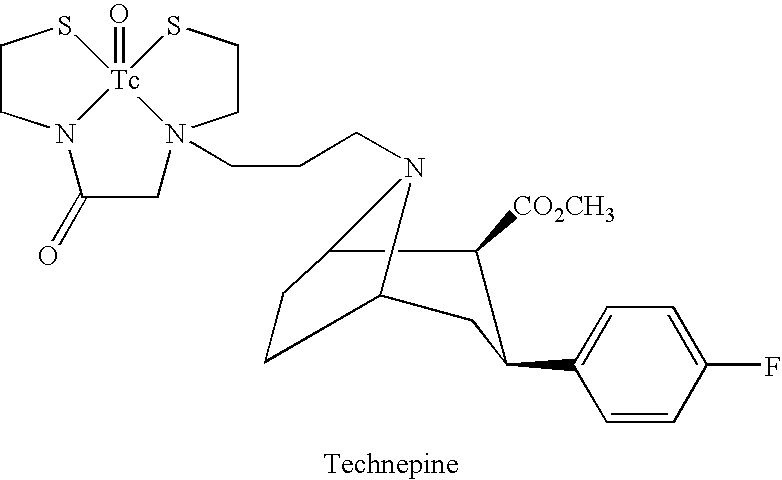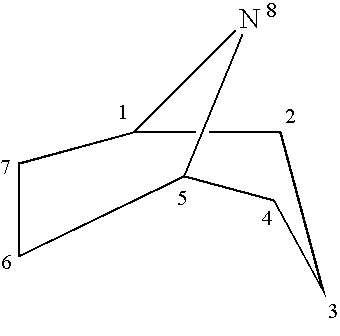Radiometal complex compositions
a technology of complex compositions and radioactive elements, applied in the field of radioometal complex compositions, can solve the problems of insufficient radioactive emission of sup>99/sup>tc for medical imaging, and achieve the effects of increasing the ratio of 99tc/99mtc, and increasing the radioactive concentration
- Summary
- Abstract
- Description
- Claims
- Application Information
AI Technical Summary
Benefits of technology
Problems solved by technology
Method used
Image
Examples
example 1
Materials and Methods
[0119] All studies were carried out using lyophilised kit formulations. The kit vials were prepared under the same conditions but to different formulations—that of the present invention (Formulation P), and that of the prior art Choi et al formulation (Formulation Q). All vials were stored upright, in the dark at −20° C. until required for use. The 99mTc-pertechnetate eluate was obtained from Amertec II™ generators (for Examples 3 to 7), Drytec™ generators (for Examples 8 and 9), and Ultra Technekow™ and Elutec™ generators (for Example 8). The kit formulations are given in Table 1:
TABLE 1Present Kit Formulation (P) vs that of the Prior Art (Q).Quantity of component per vialFormulation QKit componentsFormulation P(prior art)TRODAT-110μg*10μgSnCl2.2H2O38μg38μgNa-Glucoheptonate010mgNa-Gluconate10mg0Na2EDTA.2H2O840μg840μgNa-Ascorbate500μg0
*Formulated as the trifluoroacetic acid salt
The most significant difference is that Formulation P contains a radioprotectant ...
example 2
Radiolabelling Procedure and Purity Determination
[0120] Unless otherwise stated, all test items were radiolabelled and analysed in the same way. Thus, once equilibrated to ambient temperature, each kit was reconstituted with 2 ml of sodium 99mTc-pertechnetate solution containing 1.5 GBq (±10%) of radioactivity (1.5 GBq corresponds to 2 patient doses of 740 MBq), heated in a boiling water bath for 20 minutes and then cooled for 10 minutes before RCP analysis by HPLC and ITLC. Time of analysis is reported as ‘post-preparation’.
RCP Determination
HPLC:
Column: Xterra RP18 3.5 μm 3.0×50 mm.
Loop size: 50 μL,
Mobile Phase: 60% 50 mM Ammonium Acetate pH 7: 40% Acetonitrile
Flow rate: 0.5 ml / min.
ITLC:
Pall ITLC-SG sheet (part number 61886) cut into strips 20 mm×200 mm and eluted with 50% 1M Ammonium Acetate: 50% Acetone
RCP calculation:
RCP=(A+B)*((100-RHT) / 100)
A=species A from HPLC, B=species B from HPLC, RHT=reduced hydrolysed technetium, species at origin from ITLC.
Speci...
example 3
Comparative Kit Performance for Different Generator Elution Conditions
[0121] Kits of formulations P and Q (as described in Example 1) were reconstituted, heated and analysed in exactly the same way, as per Example 2. Four generator elution conditions were investigated:
Generator Elution Conditions (1 to 4)
[0122] 1. Fresh eluate: 24 hrs between elutions, [0123] 2. Aged eluate: 24 hrs between elutions, >6 hour old eluate—high level of radiolysis products; [0124] 3. fresh eluate: 72 hrs between elutions, 99mTc / 99Tc ratio); [0125] 4. aged eluate: 72 hrs between elutions, >6 hour old eluate—low 99mTc / 99Tc ratio and high level of radiolysis products.
[0126] RCP determinations were carried out at two post-preparation time points. The results are shown in Table 2:
TABLE 2Radiolabelling of Formulations P and Q under four differentgenerator elution conditions.GeneratorTime PostElutionPreparationMean % RCPMean A:BConditionFormulation(h & min)(S.D.)ratio1P0 h 2 min91.7 (1.2)45:55(n = 3)3 h 2...
PUM
 Login to View More
Login to View More Abstract
Description
Claims
Application Information
 Login to View More
Login to View More - R&D
- Intellectual Property
- Life Sciences
- Materials
- Tech Scout
- Unparalleled Data Quality
- Higher Quality Content
- 60% Fewer Hallucinations
Browse by: Latest US Patents, China's latest patents, Technical Efficacy Thesaurus, Application Domain, Technology Topic, Popular Technical Reports.
© 2025 PatSnap. All rights reserved.Legal|Privacy policy|Modern Slavery Act Transparency Statement|Sitemap|About US| Contact US: help@patsnap.com



